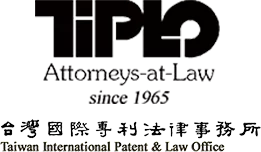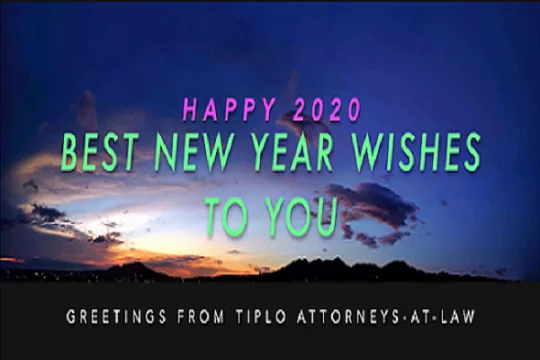The Highlights of Amendments of the Latest Trademark Law
E991015Y2 Oct. 1999(E03)
In order to meet the international provisions & for Taiwan’s accession to the World Trade Organization in the near future, our Trademark Law had been amended on May 27, 1997 and was effective as of Nov. 1, 1998. There are 9 highlights of the amendments as below:
1. Adding “reciprocal priority recognition” for an applicant claiming priority under
Article 4
There are some countries that have no treaty or agreement for reciprocal protection of trademarks with our country but who are willing to give priority protection of trademarks to the applicants of our country on the basis of reciprocal recognition. Therefore, Para. 1, Article 4 of the new Trademark Law added the term “reciprocal priority recognition” to read “An applicant who has lawfully applied for registration of a trademark in the country that has a treaty, agreement or reciprocal priority recognition with the Republic of China for reciprocal protection of trademarks may claim priority if an application for registration is filed in the Republic of China within six months counting from the next day after the first filing date”.
Up to now, the natural or juridical persons of Australia, France and the U.S.A. and applicants from the European Community may claim priority in Taiwan. According to the present practice, a U.S. applicant can claim priority based on not only the U.S. application, but also any application from Australia, France or the European Community; a French applicant can claim priority based on any application from France, Australia, the U.S.A. or the European Community. However, a U.S. applicant can not claim priority based on a U.K. or Japanese trademark application because U.K. and Japan have no treaty, agreement or reciprocal priority recognition with Taiwan.
2. Color composition and negative generalization on distinctiveness regarding
Article 5
Para. 1 of the new Article 5 stipulates that “any words or characters, drawing, symbol, color composition or their combination used in a trademark shall be sufficient to make general purchasers of goods recognize it as a mark identifying goods so as to be distinguished from others’ goods”. From this provision, it is noted that color composition could be accepted as a trademark by the new Trademark Law. Since this is a very new concept and provision in Taiwan, we have still no idea about what type of color composition could be accepted for registration. According to our experience, the Examiners are always conservative and have a rigid examination standard when initiating the use of a new provision. Gradually, the trademark authorities will have a broader standard in view of applicant’s arguments. In the cases we encountered recently, a simple color composition such as the combination of colored stripes without any words or other device is still unacceptable for registration. The Examiners still deem them non-distinctive like before.
Meanwhile, Para. 2 of Article 5 was revised to “any design not conforming with the preceding Paragraph, if it has been used by the applicant and in marketing has become a symbol identifying the goods dealt in by the applicant within his business, shall be deemed as conforming with the preceding Paragraph” in place of original provision whereby the exceptions of distinctiveness were enumerated.
Under the present practice, a simple line or circle, undesigned numerals, slogans, geographical terms, descriptive words, extendable devices, packaging decoration and so on would be deemed as non-distinctive. In general, most non-distinctive marks would be accepted for registration provided that the applicant agrees to delete or disclaim the portion of non-distinctiveness or could submit photocopies of world-wide registration certificates (especially those in the U.S., England, Canada, Australia, Hong Kong, Singapore, Mainland China) as well as sales records (such as shipping documents, sales figures, advertising expenditure) together with advertising materials to prove the mark has been widely used and registered in the world and possessed distinctiveness before filing. The more documents and materials we submit, the more chances of success we can expect for registration.
3. Specifying the means to use a name concerning Article 23
Para. 1 of the old Article 23 stated that where one’s own name or tradename is used mala fide it will be subject to restriction of the exclusive right of a trademark owned by another person. Actually, it is hard to say that mala fide use of other
descriptive words should not be subject to the restriction of other’s exclusive right of
trademark. Therefore, Para. 1 of Article 23 was amended to “Appendantly affixing to goods, by means of bona fide and reasonable use, of one’s own name, tradename, or the name, shape, quality, utility, place of origin of the goods or other descriptions of the goods per se, not used as a trademark, shall not be subject to restriction of the effects of the exclusive right of trademark owned by another person” for a more complete definition.
4. Extending the term to file a renewal application in relation to Article 25
After evaluating practical needs, the trademark authorities thought that the one-year term to file a renewal application was apparently too long. It would be adequate to limit such term to six months before the expiration date. Also, in consideration of the rights and interests of trademark owners, a six-month grace period after the expiration date was given. Under the circumstances, Para.1 of Article 25 was amended to read “Application for extension of the period of exclusive use of trademark shall be made within six months before or after the expiration of the existing period; however, an applicant files the application within six months after the expiration of the existing period, the applicant should pay double the official fee”.
Due to the above amendment, the provision “without justifiable reasons, the trademark has not been used within three years prior to the application for extension of registration, the renewal application should not be approved” in Item 2, Para. 2 of old Article 25 was simultaneously revised to become two items, namely:
Item 2: application for extension of registration is filed before expiration of the period
of exclusive use, the trademark has not been used within three years prior to
the application without justifiable reasons; and
Item 3: application for extension of registration is filed after expiration of the period
of exclusive use, the trademark has not been used within three years prior to
expiration of the period of exclusive use without justifiable reasons.
In other words, if an application for renewal is filed before the expiration date, the necessary proof of use should be dated before the filing date of renewal application; on the contrary, if an application for renewal is filed after the expiration date, the necessary proof of use should be dated before the expiration date.
In relation to the proof of use for renewal purposes, there is a new practice in Taiwan. According to an announcement published in our Trademark Gazette dated Jan. 16, 1999, applicants, as of Jan. 1, 1999, can use a Declaration instead of proof of use. Nevertheless, from the footnotes of the announcement, it is noted that even if such a Declaration is submitted, it might still be necessary to submit substantial proof of use if the Examiner has suspicions about the truth of statement referred to in the Declaration.
Because this is a very new practice, we are still unsure what kinds of materials together with a Declaration will be accepted by the Examiners or what circumstances will make them suspicious. Under the circumstances, for the sake of prudence and to make sure the client’s renewal application will be approved, we would rather suggest our clients to place an advertisement in a local newspaper which is acceptable as proof of use for renewal where the client is unable to provide with the substantial proof of use.
5. Conditions on naturally extinguished exclusive right of a trademark regarding Article 34
In order to conform to the amendment on the term to file an application for renewal, Item 1 of Article 34 was simultaneously revised to “no extension of the registration is made in accordance with the provision of Article 25, the exclusive right of a trademark shall be naturally extinguished” to replace “no extension of time is made before the expiration of the period of exclusive use of the trademark”.
Meanwhile, the provision “the owner of the exclusive right of a trademark is a juristic person who has been dissolved or whose registration has been cancelled by the agency in charge, the exclusive right of a trademark shall be naturally extinguished” in Item 2 of old Article 34 was removed on the ground that 1) the exclusive right of a trademark is an important and a monetary right which can be made as the object of a pledge, 2) no identical and/or similar provisions had been made in other countries of the world and 3) to avoid causing any problems or difficulties while we are applying for joining international organizations.
6. Protection of famous trademarks or symbols in regard to Item 7 of Article 37
Protection of famous trademarks or symbols is a world-wide trend and a principle precisely denoted by TRIPS (Agreement on Trade-Related Aspect of Intellectual Property Right) and the Paris Convention. Therefore, it was necessary that the new Trademark Law expressly stipulate this principle to avoid causing any misunderstanding while we are applying for accession to the World Trade Organization. In compliance with the provisions of TRIPS, Item 7 of Article 37 was amended to read “Identical with or similar to another person’s famous trademark or symbol so as to be likely to cause the public to have a mistaken belief; however, this provision shall not apply where the applicant is applying for registration with the consent of the owner of the trademark or symbol or the licensee”.
What kind of trademark or symbol could be deemed as famous? How do we prove it? In order to define the “famous trademark or symbol” referred to in the new Trademark Law, the “Determinant Point of Famous Trademark or Symbol” was released on March 9, 1999 by our Intellectual Property Office. However, this determinant point is merely an examination standard for the Examiners. It is impossible to file a request for famous mark or symbol.
In present practice, to claim a famous trademark or symbol in an opposition and/or invalidation action, it is necessary to submit the following evidences and information to support the action:
1) advertisements in domestic and overseas newspapers, magazines, televisions etc.;
2) invoices, sales places, import/export permits of products and the detailed statistics of quantity and amount of sales nation-wide;
3) the related evidences on ranking for brands, expenditure of advertisement and turnover of sales; and
4) market surveys, revenue of company business, and history of the trademark concerned.
7. Deletion of 2-year protection in respect of Item 12 of Article 37
Since an application for renewal can be filed within six months after the expiration of the period of exclusive use under the new Article 25, the 2-year protection of a registered trademark after expiration is no longer necessary, and thus was deleted.
8. Definition of plagiarism in Item 14 of Article 37
In order to maintain market order, a new provision was added in Item 14 of Article 37, i.e. “identical with or similar to a trademark firstly used by another person on the same or similar goods and existence of the trademark is acquainted by the applicant who having a contractual, geographic, business or other relationship with the said other person. However, this provision shall not apply if the applicant has obtained the consent of the said other person”.
In our opinion, it is unreasonable that this provision shall only apply to the condition of “the same or similar goods”. As a matter of fact, there are some trademarks plagiarising other’s trademarks but not designated for use on the same or similar goods. In that case, if the genuine trademarks are not so-called famous marks, their owners will not be in a position to oppose and/or invalidate such same or similar marks based on either this provision or the provision of Item 7 of Article 37. This is a legal loophole in the new Trademark Law. The trademark authorities shall deal with it to prevent plagiarism.
9. Article 61 – Widening the range of infringing objects for destruction
The objects for destruction stipulated in the old Article 61 were limited to only the trademark and relevant documents which are used or useful in committing the infringing act. Referring to the provision of TRIPS, Item 3 of new Article 61 widened the objects for destruction and was revised to read “the owner of exclusive right of a trademark, in accordance with the preceding two paragraphs, may request for destruction or other necessary steps on the articles infringing the exclusive right of trademark or raw materials or instruments in committing the infringing act”.
--------------------------------------------------------------------------------------------------------
The Current Developments of Famous Trademark in Taiwan
"The Determinant Point on Famous Trademark or Symbol" in Taiwan was enacted and announced on March 9, 1999 by the Intellectual Property Office (IPO).
First of all, the background for the latest publication of guidelines on "Determinant Point on Famous Trademark or Symbol":
The provision to protect famous trademark or symbol was enacted in accordance with Para. 3, Article l6 of the Agreement on Trade - Related Aspect of Intellectual Property Rights (TRIPS) and Item 7, Article 37 of the Trademark Law in order to prevent the public from confusion, misidentification and association with the owner of a trademark or symbol when it is used by another person on dissimilar goods or services. Therefore, the determination of the fame of a trademark or symbol rests upon consuming public recognition, regardless of whether it is registered or not with the agency in charge of trademarks in Taiwan. A trademark or symbol should be considered famous, no matter whether it belongs to the person in any country, only if the unregistered trademark or symbol conforms to the determinant points.
What is famous trademark or symbol?
In U.S.A.: In the legislating process of the United States Federal Trademarks
Dilution Act, a famous trademark will be protected by this law if
it is fairly known to a substantial portion of the U.S.
In Germany: For a famous trademark to be protected under German laws, it must
be well-known by over 60 (sixty) percent, or even 80 (eighty)
percent of the population.
In Japan: To determine the so-called "famous trademark" under Japanese
trademark practice, the geographical coverage must be nationwide
and it has to be known to a majority of the public.
However, in Taiwan: To conform with the TRIPS, Item 7, Article 37 of the
Trademark Law, promulgated on May 7, l997 has been
revised to read "identical with or similar to another
person's famous trademark or symbol so as to be likely to
cause the public to have a mistaken belief; however, this
provision shall not apply where the applicant is applying
for registration with the consent of the owner of the
trademark or symbol or the licensee". On March 9, l999,
the "Determinant Points on Famous Trademark or Symbol"
was been enacted.
-2-
Now, here are some guidelines regarding the determinant elements of famous trademark or symbol in Taiwan (Item 4). They are as follows:
1) use period and geographical coverage of the trademark or symbol.
2) goods or services range where the trademark or symbol is used and its
sales volume.
3) means, quantity, period and area of advertising and promotion.
4) distribution channels, sales places of the goods or services.
5) identifying degree of the trademark or symbol.
6) business scale and possibility of varied management of the owner of
the trademark or symbol.
7) evaluation among traders in this field or consumers.
8) other factors sufficiently determining famous trademark or symbol.
Next, we have a series of provision related to the evidence to prove the famous trademark or symbol (Item 5). They are as follows:
1) invoices, distribution receipts, import/export documents and sales
figures/statistics etc. for the products or services nationwide.
2) materials showing advertisements consecutively made in mass media
including local/foreign newspapers, magazines or TV etc.
3) arrangement of sales channels, places of nationwide sales points.
4) materials showing evaluation in this field, ranking of sales volume,
ranking of advertisement expenditure or business status etc. in the
market of the trademark or symbol.
5) evidence showing the date the treademark or symbol was created and
used and continuous use etc.
6) domestic and overseas registrations of the trademark or symbol.
7) relevant certificates issued by chambers of commerce, related associations
or any other reliable organizations or market survey report etc.
8) viewpoints or relevant decisions of related agencies in charge.
9) other materials evidencing fame of trademark or symbol.
-3-
Following, there are several points which should be considered:
Item 6: Use of trademark or symbol is not limited to use conducted by the owner of
trademark symbol itself. The factor that the trademarks or symbol used by its affiliate or a third party helps promoting renown of the trademark or symbol may be incorporated into Item 4 of this Point for consideration.
Item 7: The design and date should be manifested in use evidence of
trademark or symbol or other materials for identifying, regardless of whether it is used in this country. However, judgement on the evidence/materials in other countries should be based on whether domestic relevant public knows or not.
Item 8: The evidence of famous trademark or symbol may not be accepted if
the famous trademark or symbol itself is against good morals or in the process of turning famous it is against good morals or violates laws.
Item 9: The determination regarding whether a trademark or symbol is
famous should be made by the agency in charge of trademarks according to the evidence listed in Item 5 and factors listed in Item 4 of this Point. However, this Item shall not apply to the facts that the public knows.
Item 10: To determine when a trademark or symbol become famous
1) The determination of time of a famous trademark specified in the proviso of Para. 2, Article 22 of the Trademark Law is based on the time that the Applicant filed for an application for registration.














